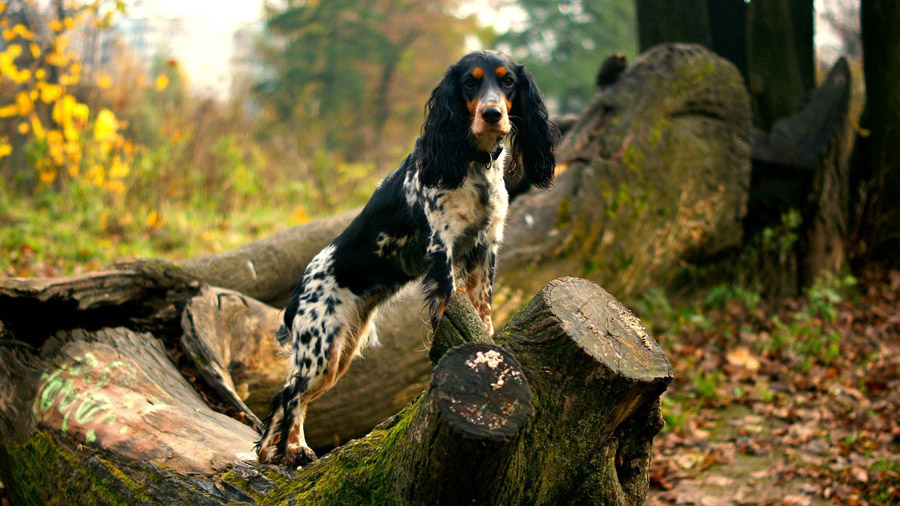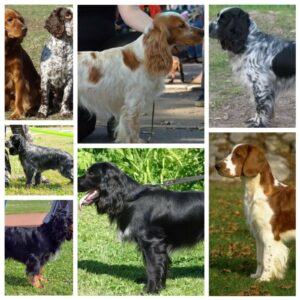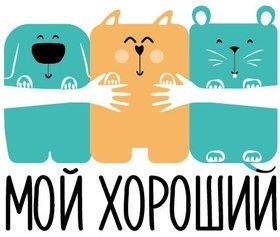
Основная информация
| Название породы: | Русский охотничий спаниель |
| Страна происхождения: | СССР |
| Время зарождения породы: | 1951 год |
| Тип: | собака-компаньон |
| Вес: | 15–20 кг |
| Рост (высота в холке): | 36—44 см |
| Продолжительность жизни: | 10 – 13 лет |
|
Классификация МКФ:
|
не признана |
| Цена щенков: | 50 – 200 $ |
| Самые популярные клички: | список кличек для русского спаниеля |
Оценка характеристик породы
| Адаптивность
(определение, означающее, насколько легко собака может приспосабливаться к изменениям в жизни) |
🐶🐶🐶🐶 |
| Уровень линьки
(Уровень и частота выпадения волос у животного) |
🐶🐶🐶 |
| Уровень нежности
(Уровень и количество нежности и ласки, которую собака отдает взамен на внимание к себе) |
🐶🐶🐶 |
| Потребности в упражнениях
(Уровень дневной активности собаки) |
🐶🐶🐶🐶🐶 |
| Социальная потребность
(Необходимое количество контактов собаки с другими животными, а также людьми) |
🐶🐶🐶🐶 |
| Квартирное содержание
(Фактор, определяющий уровень шума и иных неудобств, которые собака может доставлять хозяевам в соотношении размера квартиры к размеру собаки) |
🐶🐶🐶 |
| Груминг
(Количество купаний, расчесываний, а также необходимое количество сеансов профессионального груминга, необходимого собаке) |
🐶🐶🐶 |
| Дружелюбность в незнакомой среде
(Особенности поведения собаки в обществе с незнакомыми людьми или в незнакомой обстановке) |
🐶🐶🐶🐶 |
| Тенденция к лаю
(Склонность к лаю и его частоте и громкости) |
🐶🐶 |
| Вопросы здоровья
(Потенциальный уровень состояния здоровья собаки) |
🐶🐶🐶🐶 |
| Территориальность
(Склонность собаки к защите своего дома, двора или даже автомобиля хозяина) |
🐶🐶🐶 |
| Дружелюбность к котам
(Тенденция к терпимости к кошкам и пониженное проявление охотничьих инстинктов) |
🐶🐶🐶🐶 |
| Интеллект
(Способность собаки к мышлению и решению возникающих трудностей (не стоит путать с обучаемостью!) |
🐶🐶🐶🐶🐶 |
| Воспитание и дрессировка
(Уровень сложности в обучении собаки выполнять определенные действия) |
🐶🐶🐶🐶🐶 |
| Дружелюбность к детям
(Фактор, определяющий насколько собака дружелюбна к детям, любит ли она с ними играть и терпеть некоторые детские шалости) |
🐶🐶🐶🐶 |
| Игровая активность
(Понятие определяется самим его названием, и, как правило, встречается почти у всех собак) |
🐶🐶🐶🐶 |
| Наблюдательность
(Способность собаки определить присутствие чужого на своей территории) |
🐶🐶🐶🐶🐶 |
| Дружелюбность к другим собакам
(Склонность собаки находить общий язык с другими своими сородичами) |
🐶🐶🐶🐶 |
Краткое описание породы
Русский охотничий спаниель – порода отечественных подружейных собак, выведенная в результате скрещивания многих разновидностей спаниелей (английские кокер-спаниель, спрингер-спаниель, суссекс-спаниель и др.). Излишне длинная шерсть и невысокий рост прародителей современных русских спаниелей не позволяли этим собакам быть полноценными помощниками на охоте. Целью кинологов стало вывести такую породу, которая включала бы в себя все достоинства спаниелей и исключала недостатки. Собаки этой породы обладают крепким телосложением, они достаточно высоки в холке, конечности их прямые, параллельные. Русские охотничьи спаниели имеют отлично развитую мускулатуру, подтянутый живот, длинную и густую шерсть, обладают невысоким ростом (суки – от 35 до 42 см, кобели – от 37 до 45 см), вес собак колеблется от 15 до 20 кг. Индекс растянутости у сук 115-120 см, у кобелей – 110-115 см. Русские спаниели имеют несколько вариантов окраса: одноцветный (рыжий, коричневый, черный), двухцветный (черно-, рыже-, коричнево-пегий), трехцветный (пятнистый белый, черный и коричневый с подпалинами). Цвет глаз собак данной породы имеет карий оттенок. Хвост собак купируется на половину длины. Живут русские спаниели около 10, редко 20 лет.
Преимуществами данной породы можно считать одновременное служение человеку во время охоты и в домашней обстановке. Являясь подружейной собакой, русский охотничий спаниель помогает хозяину найти добычу во время охоты, выслеживая ее, а потом и принося хозяину. Русских спаниелей берут на охоту на зайцев, водоплавающую, болотную и полевую птицу. Собаки породы русский охотничий спаниель отличаются подвижностью и активностью, то есть владельцу придется уделять должное внимание воспитанию животного и уходу за ним. Такие собаки идеальны для семей с детьми, поскольку отличаются дружелюбием и уживчивостью. Поскольку порода русский спаниель была создана с целью участия в охоте, преимущества этих животных во время вылазок на природу очевидны. Во-первых, русского спаниеля удобно транспортировать за счет относительно небольших роста и веса. Во-вторых, собаки этой породы довольно быстро и легко натаскиваются, а скорое оформление скелета и мышечной массы позволяют им начинать охоту с 7-8 месяцев. Кроме того, русские спаниели показывают отличные результаты во время охоты на боровую (тетерев, рябчик, глухарь и пр.), полевую (куропатка, перепел), болотную (кулик, цапля, журавль), водоплавающую (гуси, утки) птицу, на мелких зверьков (белки, зайцы), то есть эти собаки практически универсальны (согласно их размеру).
История происхождения
Предки сегодняшних русских охотничьих спаниелей изначально были выведены путем скрещивания длинношерстных легавых. А исторической родиной спаниелей принято считать далекую Испанию, хотя настоящую популярность среди охотников эти собаки завоевали в Англии. В нашу страну спаниели (кокер, спрингер, суссекс, фильд и др.) начали ввозиться с 1884 года, но настоящий спрос на эту породу начался после Великой Отечественной войны.
Хотя стандарт породы был разработан и введен только в 1951 году, русские спаниели существовали задолго до этого. Завоз спаниелей, которые и дали развитие новой породе, начался с конца XIX века, а уже в начале нового столетия проводились меры по селекции собак, предназначенных для помощи человеку во время охоты, при этом адаптированных к климату и природным условиям, которые были характерны для нашей страны.
Кокер-спаниели завоевывали популярность среди охотников, но не могли в силу своих физических данных приспосабливаться к болотистой, труднопроходимой местности, они погрязали в снегу в зимнее время. Война существенно повлияла на работу специалистов по выведению новой породы, однако вывезенные из страны и вновь прибывшие уже в мирное время в СССР собаки позволили начать работу по селекции. Скрещивание многих разновидностей спаниелей позволило вывести новую породу, которая и была официально признана 65 лет назад. Считается, что русский охотничий спаниель – это одна из самых молодых пород, выведенных в нашей стране.
Окрасы:
Характер русского спаниеля
Содержание и уход
Потенциальному владельцу собаки такой породы стоит изначально определиться с тем, для каких целей он собирается приобрести животное. Если собака должна стать компаньоном и помощником во время охоты, то с самого мальства не следует слишком баловать ее. К примеру, неразумно кормить охотничьего пса пищей со стола, позволять проявлять большое любопытство и совать свой мокрый нос, куда не следует. В идеале собака должна слушаться своего хозяина и безоговорочно реагировать на его запреты. Поскольку русские спаниели являются животными чрезвычайно активными, владельцу придется совершать долгие по времени ежедневные прогулки на свежем воздухе в любую погоду (гулять с собакой следует перед кормлением). Щенков в возрасте до 8 месяцев выводят на прогулку не менее 3 раз в день, взрослая собака нуждается в двухразовом моционе ежедневно. При этом время прогулки должно составлять не менее получаса (желательно час и более). После выхода на улицу собаку необходимо вычистить щеткой, тщательно протереть или вымыть лапы. Если собака будет сопровождать хозяина на охоте, то с полугода следует брать ее с собой на вылазки, чтобы животное постепенно привыкало к местности.
Перед приобретением такой собаки следует отвести ей определенное место, где не будет сквозняков, а температура в комнате не будет слишком высокой. Предпочтительнее выбирать то помещение, где не будет шумно, где собаку не будут постоянно преследовать посторонние запахи (к примеру, на кухне во время приготовления пищи) и сырость – все эти факторы в будущем влияют на чутье и здоровье четвероногого друга. Спальное место собаки должно быть оснащено удобной лежанкой, за чистотой которой владелец должен неукоснительно следить. Для щенка на некоторое время целесообразно поставить рядом с подстилкой небольшую коробку с наполнителем для туалета, но только до той поры, пока малыш не приучится к постоянным прогулкам. У собаки должны быть миски для пищи и воды, которые следует регулярно мыть. Длинная шерсть русского спаниеля потребует покупки щеток, гребней и расчесок для ухода. Кроме того, хозяин собаки должен иметь в наличии ошейник, поводок, намордник. Неплохо продумать и наличие игрушек для собаки, особенно в тех случаях, когда она не имеет возможности гулять подолгу, а большую часть времени проводит в квартире. В качестве развлечения можно использовать приобретенные в зоомагазинах резиновые шарики-пищалки, детские игрушки из резины, не имеющие съемных деталей.
Помимо ухода за роскошной шерстью следует периодически купать собак данной породы, но не чаще 3-4 раз в год, начиная с 6-месячного возраста. Для купания следует использовать специально разработанный для собак шампунь и теплую (не горячее 30-33 градусов) воду. Во избежание аллергии не стоит купать животных шампунями, созданными для людей. В летнее и теплое время русские спаниели обожают плавать в открытых водоемах, что позволяет не только закреплять и закалять их организм, но и тренировать для участия в охоте.
Русские спаниели довольно стойко переносят холод, что позволяет содержать их не только в городских квартирах, но и на улице, при условии, что температура воздуха не будет ниже 10 градусов. Для этого владельцу нужно иметь не только необходимый для постройки вольера и будки собаки участок, но и позаботиться об утеплении уличных апартаментов животного. Без определенных навыков и правильного подхода, которые понадобятся для создания комфортных условий проживания, животное может запросто заболеть. Кроме того, уход за собакой, проживающей на свежем воздухе, значительно усложняется. К примеру, владельцу придется продумывать процедуры купания, частого общения с собакой. Именно поэтому лучше содержать русского спаниеля именно в квартире.
Дрессировка и обучение собак породы русский охотничий спаниель
Малыши русские спаниели, как правило, обретают свой новый дом и нового хозяина в возрасте 2-3 месяцев. В первые дни пребывания в квартире владелец должен проявлять максимум внимания и терпения, понимая, как нелегко дается щенку разлука с матерью и привычной для него обстановкой. Но вскоре малыш уже начинает осваиваться и проявлять интерес буквально ко всему – жителям квартиры, мебели, обуви и так далее. Уже на этом этапе владелец должен начинать приучать животное к дисциплине, по-доброму, но в то же время строго (без крика и избиений) обучать щенка простым командам. Излишняя агрессия и нетерпеливость со стороны владельца могут с раннего возраста проложить пропасть в отношениях между ним и животным. А вот добрый подход окупится очень скоро, потому что русские спаниели добродушны и преданны своему хозяину на протяжении всей жизни при правильном воспитании.
Следует понимать, что охотничья собака должна быть послушной, для этого у нее должен быть один непререкаемый авторитет – хозяин. Поэтому не стоит воспитывать щенка всей семьей, когда один человек что-то запрещает, а другой – наоборот, поощряет. Даже маленького щенка не стоит допускать ко сну на кроватях, диванах, угощать его той пищей, которая для него не предназначена (человеческая еда только навредит). Перевоспитать животное в последующем будет очень трудно.
Дрессировка собак породы русский охотничий спаниель – трудоемкое, но благодарное дело, поскольку эти животные легко обучаемы и послушны. Навыки собак, приобретенные при дрессировке, воздействуют на условные и безусловные рефлексы, раздражители, что позволяет выполнять команды хозяина. В процессе дрессировки владельцем используются несколько способов, заставляющих собаку понимать команду: вкусопоощрительный (когда привыкание к командам осуществляется при помощи лакомства), механический (выполнение команды посредством силового воздействия), контрастный (совмещение пищевого поощрения и механического воздействия), подражательный (копирование неопытной особью действий обученной собаки). Со временем собака выполняет команды владельца без вкусностей и применения силы. В процессе обучения дрессировщик применяет методы поощрения (если животное правильно и послушно выполняет команду), принуждения (если животное не выполняет известную команду), запрещения (для прекращения нежелательного действия собаки).
Дрессировщику следует хвалить собаку лишь тогда, когда есть отличный результат работы. Наказывать не следует чрезмерно (бить, громко кричать) во избежание потери контакта с животным. В качестве механического воздействия будет достаточно легкого давления на круп животного, легкого удара прутом и выраженной интонации запрещения. Все команды должны произноситься четко, не следует заменять слова команды (к примеру, «ко мне» нельзя заменять схожим по смыслу, но другим по звучанию «иди сюда» или др.).
Здоровье и болезни
Одним из главных недугов, поражающих собак породы русский охотничий спаниель, является воспаление в ухе – отит, что усугубляется наличием у них длинных висящих ушей. Не вылеченный отит может привести к потере слуха и другим тяжелым последствиям. Если животное часто трясет головой, присутствуют выделения (часто гнойные) из ушей, отказывается от пищи, то следует обратиться к ветеринару для постановки диагноза и лечения.
Кроме того, шикарная шерсть русских спаниелей может быть прекрасным домом для кровососущих паразитов. Поэтому не стоит пренебрегать назначенными ветврачом профилактическими мерами по борьбе с клещами, блохами. Дегельминтизация и профилактические меры по борьбе с глистами необходимы этим собакам, как и прочим домашним животным. С вакцинацией против болезней владельцу следует проконсультироваться со специалистом и проводить ее ежегодно во избежание трагедии.
Для здоровья собаки необходимо продумывать ее пищевой рацион, который должен включать в себя достаточное количество белков, углеводов, жиров, витаминов и минеральных веществ. В идеале для русских спаниелей можно сочетать мясо и субпродукты с кашами и овощами, можно давать молоко и молочные продукты, куриные яйца. Но все ингредиенты должны быть качественными и свежими. Не стоит кормить животное костями, давать в пищу блюда, приправленные перцем, горчицей, другими соусами. Пища должна быть теплой, но не горячей. Неплохой альтернативой натуральной еде являются готовые корма, но следует обращать внимание на их состав. Неправильное кормление резко негативно влияет на здоровье русских спаниелей.
Несколько интересных фактов
- Одним из самых грустных моментов является непризнанность данной породы Международной кинологической федерацией. Предки русских охотничьих спаниелей давно внесены в классификации пород, но выведенные в нашей стране русские спаниели неоправданно остаются в тени. Несмотря на такое положение дел, порода набирает все большую популярность, как у охотников, так и у обычных любителей благодаря уму, доброте и выносливости этих удивительных животных.
Питомники и заводчики
Материал мы заимствовали с замечательного сайта наших партнеров DOGCATFAN.COM о кошках и собаках, автор dogcatfan
Интересные профили:
Посмотреть эту публикацию в Instagram
Посмотреть эту публикацию в Instagram
Посмотреть эту публикацию в Instagram
